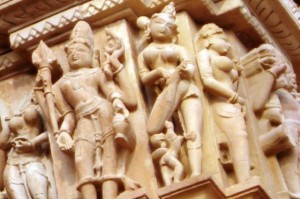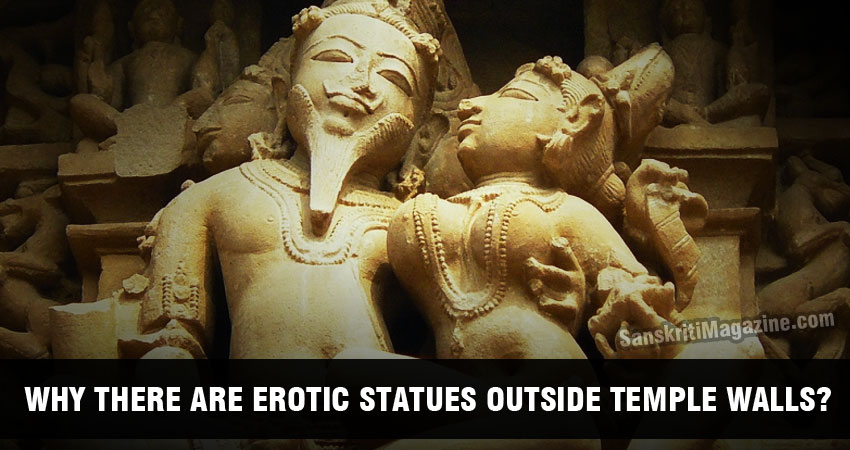Sex symbols have been associated with Hinduism from an early stage. These symbols were mainly part of nature worship. There is difference of opinion regarding the exact reason for sex sculptures in Hindu temples. And the notion of Hindu sex temples is wrong. A Classic example is Khajuraho where only 20% of the sculptures are sex sculptures and that too they are depicted along with other aspects life, but they are the only part which are highlighted and advertised negatively throughout the globe and in India by those who need an excuse to do whatever they feel like.
A SCIENTIFIC PERSPECTIVE:
Pune-based Indologist Udayan Indurkar takes groups of tourists to Khajuraho, Ajanta and Ellora to explain the significance of these world heritage sites.
There’s a deeper significance to the erotic sculptures of Khajuraho in the Chhatarpur district of Madhya Pradesh and people like to hear Indologist Udayan Indurkar talk about them.
Recently, he was invited by a group of sexologists to explain to them the sculptures of divine couples on the temples of Khajuraho.
“These are often described as obscene and I strongly object to that. Come with me to Khajuraho and I will explain why,” challenges Indurkar.
It probably needs someone scholarly and well-informed like 56-year-old Indurkar to tell us how our ancestors have carved out our entire culture, knowledge and the essence of our civilisation in the stones of Khajuraho, Ellora (also called Verul in Marathi) among other ancient monuments.
Indurkar believes that the masterpieces of art in India have been lying under layers of ignorance for centuries.
As a member of an archaeological society called Blushing Indian Stones, he has conducted about 100 tours to the magnificent temples and caves in India with the sole intention of revealing the larger truths behind them.
According to him, they lead an observer to his inner self. Khajuraho represents the zenith of Indian temple architecture, he says, while blaming the British for labeling it as obscene in its character.
“Before the arrival of the British, Khajuraho was considered as a place where divine ecstasy exploded. The Westerners called it obscene because they did not get its true meaning,” he says. This Indologist notes that ancient Indian literature describes sex as an art of experiencing the explosion of divine ecstasy.
“It is similar to cosmic explosion in the universe. During such explosions, atoms with energy come together, heat is created that leads to an explosion and energy is released,” he says while trying to explain the concept in layman’s language.
“In such explosions there is no external supply of energy, it comes from within. Similarly in the act of sex, energy is created within the person and is released. The sculptures are not aimed at showing the physical union but the cosmic truth.”
He pointed out that all these sculptures are outside the temple and not within. This also holds a message. “No one knows how the atoms acquired energy. It was always there, that’s what we call god. The cosmic explosion is explained through the sculptures outside the temple and then one is led into the temple to be one with the energy itself that you find in the sanctum sanctorum,” he says.
Look at these sculptures and paintings as knowledge in frozen form. They were done in stone to ‘freeze’ the knowledge and pass it on to future generations. “If you minutely observe, you will find that all forms of sculptures are living performances of drama, music, mythology, religion, philosophy, science, literature and poetry as well,” he notes. Indurkar asks tourists to look for scientific concepts in the sculptures. Concepts of evolution, the relationship between humans and god, human follies and weaknesses and various shades of virtues and vices are all explained therein.
“Ellora,” he says, “is a masterpiece.” Every carving is unique. For example, the sculpture of Parvati and Lord Shankar showing Parvati holding the hand of the lord while he has placed his left hand on her shoulder, during their wedding. “Observe her feet. She is rubbing her right toe with her left one which depicts embarrassment,” he says.
Be it the temples of Khajuraho, Konark, Puri the splendid Gopuras from South India, Rani Ki Vav at Patan in Gujarat or the Kailas temple at the Ellora caves in Aurangabad, they are all expressions of art. Indurkar has presented more than 700 slide shows and now intends to create a comprehensive website on Indian temple art and architecture.
ANOTHER INSIGHTFUL PERSPECTIVE:
WHAT TO EXPECT FROM KHAJURAHO?
 Hundreds of tourists come daily, see the sculptures, pass their own judgments, and leave. But none seemed to be excited by looking at them. They all seemed disappointed that the eroticism they had expected was missing. Travel brochures and exaggerated publicity are responsible for this. The travel guides too seemed to exaggerate the sculpture and regularly cooked up stories in order to extract tips. No wonder that those who come here expecting a Las Vegas will be disappointed, because there is only pure beauty and no perversion in these temples. Creations such as a cabaret or pornography, which are designed to excite human sexuality, are absent here. Even the magnetism of a curvaceous female body is missing from these sculptures.
Hundreds of tourists come daily, see the sculptures, pass their own judgments, and leave. But none seemed to be excited by looking at them. They all seemed disappointed that the eroticism they had expected was missing. Travel brochures and exaggerated publicity are responsible for this. The travel guides too seemed to exaggerate the sculpture and regularly cooked up stories in order to extract tips. No wonder that those who come here expecting a Las Vegas will be disappointed, because there is only pure beauty and no perversion in these temples. Creations such as a cabaret or pornography, which are designed to excite human sexuality, are absent here. Even the magnetism of a curvaceous female body is missing from these sculptures.
WHY EROTICA IN TEMPLES?
There are different opinions on why temples were decorated with sexually explicit sculptures. One group argues that the old kings lived in obscene luxury and that they used these for excitement. Another group thinks that it was part of sexual education in ancient India: since most people visited temples, it was an appropriate place for mass communication. Some scholars say that since Hinduism believes in the efficacy of all four paths to Moksha (Dharma, Artha, Yoga
WHY NOT ?
“All of life is God’s magic;” we are all parts of divinity; our scriptures argue that to attain moksha, and to dedicate ourselves to dharma and adhyatma. The one who wrote the Kamasutra was none less than a sage! When the Gods themselves cannot escape the web of Kama, what about us mere mortals? We have saints and mystic figures (Purana-Purusha) who have sinned, we have sages who have abandoned their years of renouncement for a beautiful woman, If one concedes that sex is an important and integral part of life, mortals must experience it completely. Only perversions are excluded.
Not all nations can have the same laws or customs about sexual behavior. What is considered natural in one may be prohibited in another. In the same country, what is considered perversion may eventually become to be acceptable. In India we consider kissing as a sexual act whereas in western countries it is a symbol of affection and is used just like a handshake. In West, most parts of society and the government do not object to exposing the body, except for the private parts. In England and France, nude dancing in theaters is a popular art form. In England where they once punished a scholar such as Oscar Wilde for homosexuality, the practice is legal today. In the holy land of India, where it was once thought that embryo-homicide (bhroona-hatya) was a great crime, today it is a legal process approved by the government and society. How quickly the standards of acceptance change!
These sculptures were created by the artist’s imagination of lovemaking positions prevalent at that time, or based on the rules outlined in the Kamasutra. Irrespective of how they were modeled, we have to agree on the extraordinary capabilities of the sculptors. No Indian has to be ashamed of these temple sculptures. On the other hand, we should be proud of the advanced representations of sexuality made thousands of years before Alfred Kinsey published his scientific analysis of human sexuality in 1948.
 STATE-OF-THE-ART ?
STATE-OF-THE-ART ?
Just as we begin scientific research today by performing a wide survey of existing material on the topic, the ancient Indians must have first put together all the available information at the time on the topic (sexuality). The Kamasutra of Vatsyayana an
If we concede that these sculptures are completely imaginary, then we must admire the grand imagination of our ancestors! It must have taken enormous talent to sculpt postures that artists never practiced or saw. Many of the sculptures have the artists names carved under them and it is impossible for me to think that these creations were considered vulgar, if the sculptor felt compelled to claim artistic ownership.
Although Khajuraho is most famous for these sculptures, most Indian temples have them in one form or another. Belur, Halebidu, Somanathupura, and Nugguhalli temples of the Hoysala period have many such beautiful sculptures. The Badami and Banashankari temples of the Chalukya times, and the Vijayanagar temples of Bhatkal, Lepakshi and Hamp











